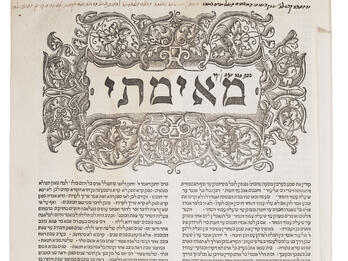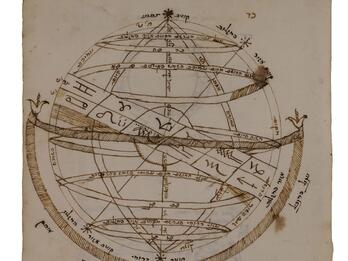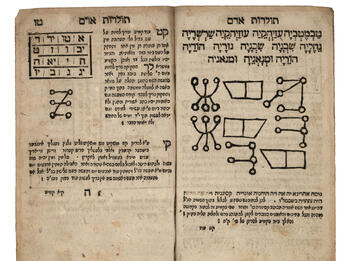Early Modern Religious Practices
Early modern Jews both preserved tradition and innovated. Documents and legal texts reveal rich details about synagogue life, marriage, family relations, and death rituals.

Halakhah (Jewish law) left its mark on every area of Jewish society, in both the public and the private spheres. The Posen Library presents dozens of passages from a rich assortment of documents, including halakhic codes, books of rabbinic responsa, compendiums of customs, kabbalistic writings, community registers, the bylaws of confraternities, family letters, and wills. These shed light on a full range of aspects of the Jewish ways of life during this period, and they come from most congregations and Jewish cultural centers around the world. One exceptionally important text was that of the Shulḥan ‘arukh (Set Table), by Joseph Karo. After it was printed with the annotations of Moses Isserles, called ha-Mapah (The Tablecloth), it was accepted throughout the Jewish diaspora, by Sephardic Jews as well as by those of Germany and Poland. In theory, it dictated the conduct of every Jew, no matter where.
Selections in the Posen Library discuss the place of the synagogue in the life of the Jewish people, examining the various functions filled by this institution, rules for preserving proper behavior there, and some of the arrangements (and conflicts) among synagogue functionaries, according to a range of sources, including ethical works, responsa, and congregational regulations. The texts touch on such topics as permissible synagogue decoration, cantorial practices, regulations about who may and may not preach, and the distribution of honors in the service.
Liturgy
The rise of print and the resulting widespread availability of printed prayer books tended to make Jewish liturgical practice more uniform over this period. In some of these texts, however, we see remnants of older, now-lost ritual practices, such as Shavuot festivities on the island of Corfu. At the same time, new liturgical practices were evolving, and new prayers were being written, some in response to the growing popularization of kabbalistic ideas. Some newly developed customs and ceremonies were the Kabbalat Shabbat (welcoming the Sabbath) service for Friday night and the Tikkun Leyl Shavuot (nighttime study sessions as part of the holiday of Shavuot). In addition, small confraternities of devotees, such as the Shomrim la-boker (Morning Watchers), followed elaborate rituals written just for them. This section thus contains a wide range of material, including halakhic regulations for observing various holidays; a liturgical hymn for the Sabbath composed by Solomon Alkabetz; specific Sabbath customs adopted by the community of Worms; a poem in Yiddish in honor of Simḥat Torah written by Rebecca Tiktiner; passages from the anonymous compendium of ritual practices Ḥemdat yamim (Choicest of Days) on the fifteenth of Shevat, the New Year of Trees; and selections from a commentary on the Passover Haggadah by Judah Loew (the Maharal of Prague).
Family Life, Love, and Marriage
The Posen Library contains many early modern texts on the theme of love and marriage. These texts include marriage strategies and wedding ceremonies and are drawn from a wide variety of texts from different communities. One is drawn from a non-Jewish description: the Jüden Schul (translated the following year into Latin as Synagoga Judaica), by Johannes Buxtorf, one of the greatest Christian scholars of Judaism of the day. There are also fascinating texts with advice for young married husbands and wives, letters between married couples, and accounts of divorces. Rabbinic responsa have always been a rich source for details of personal conflicts between Jews in all aspects of life, and here they do not disappoint, providing evidence of secretly arranged marriages, grooms who wished to withdraw from their engagements, and more. Next are passages from halakhic sources, personal letters, and ethical works, in Hebrew and Yiddish, which shed light on the complexity of domestic relations between husband and wife and between parents and children.
Law, Custom, and Magic
In the area of law and custom, the reader will find passages from a variety of important rabbinic figures, many from the Ottoman Empire, Poland, and Central Europe. Here, too, legal discussions shine light on interpersonal disputes, but they also illuminate broader phenomena, such as the authorization of women as ritual slaughterers or the halakhic status of a new drink, coffee.
Another side of religious practices was the common and widely accepted practice of magical intervention. Most famous, perhaps, is the exorcism of evil spirits—called dybbuks among Ashkenazic Jews—but magical techniques, some drawing on traditions going back to the late-antique period, were very often deployed to prevent (and to recover from) all manner of misfortune. The texts and images here include a representative selection of amulets, many of which were produced to protect women in childbirth and their newborn infants.
Death
Some texts dealing on the topic of death are straightforward, such as the vivid and detailed instructions for contemplating one’s impending death in Elijah ha-Kohen ha-Itmari’s ethical work Shevet musar (Rod of Correction): On Contemplating Death, whereas others teach us about prevailing attitudes in more oblique ways. Burial societies, charged with ensuring that individual Jews were buried with proper dignity and according to Jewish law, had been active since the medieval period, and the reader will find in this section the regulations of the Prague burial society. There is also a devotional prayer book for visitors to the cemetery, Ma‘aneh lashon (Expression of the Tongue), also from Prague, written in Hebrew and Yiddish and published in 1615. Wills and testaments, including ethical wills, were left by the dying; because they are personal expressions of the individual, they appear instead in the section “Egodocuments.”
The Posen Library also includes a rich selection of funerary inscriptions from Padua, Amsterdam, Altona, Prague, Istanbul, and the Caribbean. Aside from the elaborate decorations of the gravestones, their inscriptions, which can include biblical verses, poetry, and personal details about the deceased, are of enduring interest.




